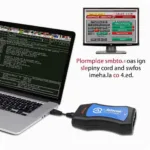The OBD2 simulator v1.5 is a powerful tool for diagnosing and troubleshooting vehicle issues. Understanding its capabilities can significantly enhance your diagnostic prowess, whether you’re a professional mechanic or a DIY enthusiast. This guide will delve into the intricacies of the OBD2 simulator v1.5, exploring its features, benefits, and practical applications.
Understanding the Power of OBD2 Simulator v1.5
OBD2 simulators, like the v1.5 version, are invaluable tools for anyone working with vehicle diagnostics. They allow you to replicate various vehicle conditions and test different diagnostic scenarios without needing a physical car. This can save time and money, especially when dealing with intermittent faults or complex systems. The OBD2 simulator v1.5 stands out for its versatility and ease of use, making it a popular choice for both professionals and hobbyists. Whether you’re looking to simulate specific fault codes, test your diagnostic tools, or simply learn more about how your car’s systems work, the OBD2 simulator v1.5 offers a comprehensive solution.
Imagine trying to diagnose a tricky intermittent problem in a car. Without a simulator, you might spend hours, even days, trying to reproduce the fault. With the OBD2 simulator v1.5, you can quickly and easily set the specific parameters needed to trigger the fault code, allowing you to pinpoint the problem area much faster.
Key Features and Benefits of the OBD2 Simulator v1.5
The OBD2 simulator v1.5 boasts several key features that make it a valuable tool:
- Simulated Fault Codes: Generate specific Diagnostic Trouble Codes (DTCs) to test diagnostic tools and procedures.
- Real-time Data Simulation: Simulate various sensor readings, allowing you to monitor how your diagnostic equipment interprets the data.
- Customizable Scenarios: Create tailored scenarios to replicate specific vehicle conditions, making it easier to diagnose complex issues.
- Protocol Support: Supports a wide range of OBD2 protocols, ensuring compatibility with various vehicle makes and models.
- User-Friendly Interface: Intuitive software and hardware design makes it easy to use, even for beginners.
These features combine to provide numerous benefits, including reduced diagnostic time, improved troubleshooting accuracy, and enhanced training opportunities.
Practical Applications of the OBD2 Simulator v1.5
The OBD2 simulator v1.5 finds applications in various settings:
- Professional Workshops: Mechanics can use it to diagnose complex vehicle problems quickly and efficiently.
- Educational Institutions: A valuable training tool for automotive students learning about OBD2 systems and diagnostics.
- DIY Enthusiasts: Empowers car owners to perform their own diagnostics and troubleshooting.
- Software Developers: Useful for testing and debugging OBD2 diagnostic software.
The simulator’s versatility makes it an indispensable asset for anyone working with vehicle electronics.
For example, a mechanic might use the OBD2 simulator v1.5 to confirm a suspected faulty sensor by simulating the sensor’s output and observing the corresponding changes in the vehicle’s diagnostic data.
How to Use the OBD2 Simulator v1.5 Effectively
Using the OBD2 simulator v1.5 is straightforward:
- Connect the simulator to your computer via USB.
- Install the necessary software.
- Select the desired vehicle make and model.
- Choose the specific fault codes or data parameters you want to simulate.
- Connect your diagnostic tool to the simulator.
- Analyze the results and troubleshoot accordingly.
With a little practice, you can quickly master the operation of the OBD2 simulator v1.5 and leverage its capabilities for effective vehicle diagnostics.
Conclusion: Unleashing the Potential of OBD2 Simulator v1.5
The OBD2 simulator v1.5 is a powerful and versatile tool that can significantly improve your diagnostic capabilities. From simulating specific fault codes to replicating complex vehicle conditions, this device offers a comprehensive solution for both professionals and enthusiasts. Mastering the OBD2 simulator v1.5 will undoubtedly enhance your understanding of vehicle electronics and streamline your diagnostic workflow.
FAQs
- Is the OBD2 simulator v1.5 compatible with all vehicle makes and models? While it supports a wide range, it’s crucial to check the manufacturer’s specifications for compatibility with your specific vehicle.
- Can the OBD2 simulator v1.5 damage my car’s computer? No, the simulator is designed to be safe and will not harm your vehicle’s electronics.
- Do I need any special training to use the OBD2 simulator v1.5? The user-friendly interface makes it easy to learn, but some basic understanding of OBD2 systems is helpful.
- Where can I purchase an OBD2 simulator v1.5? Reputable online retailers and automotive supply stores often carry these devices.
- What is the warranty on the OBD2 simulator v1.5? Warranty information varies depending on the manufacturer and retailer.
- Can I use the OBD2 simulator v1.5 with other diagnostic software? Yes, the simulator is compatible with most OBD2 diagnostic software.
- What are the system requirements for the OBD2 simulator v1.5 software? System requirements will vary depending on the specific software provided with the simulator.
For further assistance, contact us via WhatsApp: +1(641)206-8880, Email: [email protected] or visit us at 789 Elm Street, San Francisco, CA 94102, USA. We have a 24/7 customer support team.

